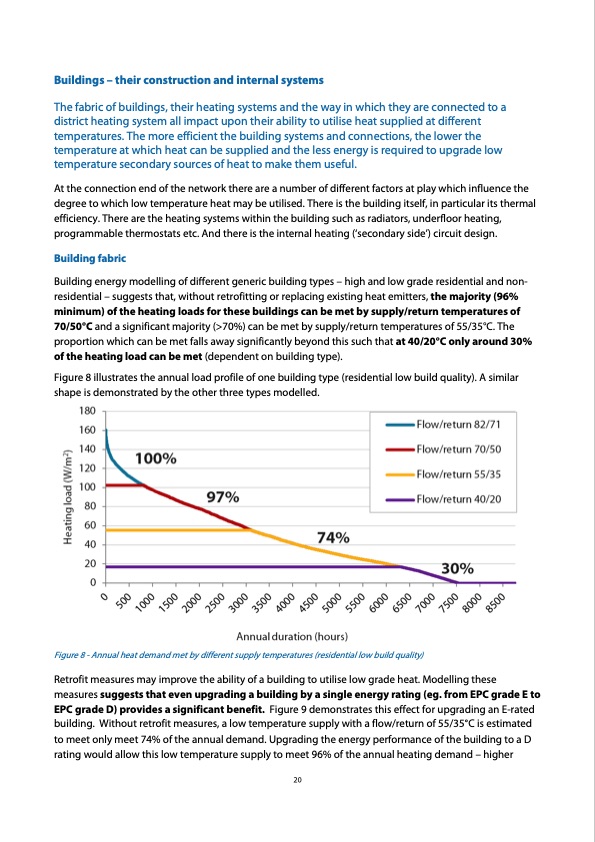
PDF Publication Title:
Text from PDF Page: 020
Buildings – their construction and internal systems The fabric of buildings, their heating systems and the way in which they are connected to a district heating system all impact upon their ability to utilise heat supplied at different temperatures. The more efficient the building systems and connections, the lower the temperature at which heat can be supplied and the less energy is required to upgrade low temperature secondary sources of heat to make them useful. At the connection end of the network there are a number of different factors at play which influence the degree to which low temperature heat may be utilised. There is the building itself, in particular its thermal efficiency. There are the heating systems within the building such as radiators, underfloor heating, programmable thermostats etc. And there is the internal heating (‘secondary side’) circuit design. Building fabric Building energy modelling of different generic building types – high and low grade residential and non- residential – suggests that, without retrofitting or replacing existing heat emitters, the majority (96% minimum) of the heating loads for these buildings can be met by supply/return temperatures of 70/50°C and a significant majority (>70%) can be met by supply/return temperatures of 55/35°C. The proportion which can be met falls away significantly beyond this such that at 40/20°C only around 30% of the heating load can be met (dependent on building type). Figure 8 illustrates the annual load profile of one building type (residential low build quality). A similar shape is demonstrated by the other three types modelled. Figure 8 - Annual heat demand met by different supply temperatures (residential low build quality) Retrofit measures may improve the ability of a building to utilise low grade heat. Modelling these measures suggests that even upgrading a building by a single energy rating (eg. from EPC grade E to EPC grade D) provides a significant benefit. Figure 9 demonstrates this effect for upgrading an E-rated building. Without retrofit measures, a low temperature supply with a flow/return of 55/35°C is estimated to meet only meet 74% of the annual demand. Upgrading the energy performance of the building to a D rating would allow this low temperature supply to meet 96% of the annual heating demand – higher 20PDF Image | LONDONS ZERO CARBON ENERGY RESOURCE Secondary Heat

PDF Search Title:
LONDONS ZERO CARBON ENERGY RESOURCE Secondary HeatOriginal File Name Searched:
031250_GLA_Secondary_Heat___Summary_Report.pdfDIY PDF Search: Google It | Yahoo | Bing
NFT (Non Fungible Token): Buy our tech, design, development or system NFT and become part of our tech NFT network... More Info
IT XR Project Redstone NFT Available for Sale: NFT for high tech turbine design with one part 3D printed counter-rotating energy turbine. Be part of the future with this NFT. Can be bought and sold but only one design NFT exists. Royalties go to the developer (Infinity) to keep enhancing design and applications... More Info
Infinity Turbine IT XR Project Redstone Design: NFT for sale... NFT for high tech turbine design with one part 3D printed counter-rotating energy turbine. Includes all rights to this turbine design, including license for Fluid Handling Block I and II for the turbine assembly and housing. The NFT includes the blueprints (cad/cam), revenue streams, and all future development of the IT XR Project Redstone... More Info
Infinity Turbine ROT Radial Outflow Turbine 24 Design and Worldwide Rights: NFT for sale... NFT for the ROT 24 energy turbine. Be part of the future with this NFT. This design can be bought and sold but only one design NFT exists. You may manufacture the unit, or get the revenues from its sale from Infinity Turbine. Royalties go to the developer (Infinity) to keep enhancing design and applications... More Info
Infinity Supercritical CO2 10 Liter Extractor Design and Worldwide Rights: The Infinity Supercritical 10L CO2 extractor is for botanical oil extraction, which is rich in terpenes and can produce shelf ready full spectrum oil. With over 5 years of development, this industry leader mature extractor machine has been sold since 2015 and is part of many profitable businesses. The process can also be used for electrowinning, e-waste recycling, and lithium battery recycling, gold mining electronic wastes, precious metals. CO2 can also be used in a reverse fuel cell with nafion to make a gas-to-liquids fuel, such as methanol, ethanol and butanol or ethylene. Supercritical CO2 has also been used for treating nafion to make it more effective catalyst. This NFT is for the purchase of worldwide rights which includes the design. More Info
NFT (Non Fungible Token): Buy our tech, design, development or system NFT and become part of our tech NFT network... More Info
Infinity Turbine Products: Special for this month, any plans are $10,000 for complete Cad/Cam blueprints. License is for one build. Try before you buy a production license. May pay by Bitcoin or other Crypto. Products Page... More Info
| CONTACT TEL: 608-238-6001 Email: greg@infinityturbine.com | RSS | AMP |